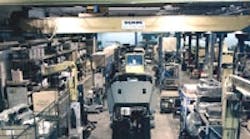Oshkosh, a Wisconsin city of 63,000 about 50 miles north-northwest of Milwaukee, is best known as the home of OshKosh B'Gosh Inc., a maker of children's wear, and the Experimental Aircraft Association Inc.'s annual summer show, an event aviation buffs refer to simply as Oshkosh.
But there's another reason to know Oshkosh. It's home to $2.96 billion Oshkosh Truck Corp. and a best practice the firm has dubbed flexible integrated manufacturing. In addition to allowing the company to be more responsive to the requests of its specialized-vehicle customers, the 2,160-foot flexible integrated manufacturing line in Oshkosh Truck's 320,000-square-foot main production facility has resulted in greater efficiency, higher quality, increased capacity and less inventory. The factory, for example, once carried up to a week and a half's worth of engines in inventory; now it's 1.5 days' worth. The truck line has more than doubled production, with a cycle time per station of about 22 minutes.
The plant's production workers, about 950 in number and members of the United Auto Workers of America, also benefit from the flexibility, Bohn says. Cross-trained, they move among tasks as required by the number and types of vehicles moving down the line. "Instead of building one type of product, we've got 40 different models that go down that assembly line . . . and it's really more interesting if you have some 40 different products that you're working on," Bohn says.
Nevertheless, the transition from old ways to new took time. "We shut the factory down several times and went through extensive training" -- a day to a day and a half on JIT, for example. "They started to believe us then," Bohn says. "It was absolutely [about] changing the culture of the company. And it was probably easier to train the hourly employees than it was the salaried people," he adds. "The hourly people were already out on the floor doing the job. Salaried people are traditionally somewhere in an office and probably not next to the assembly line."




